
About UsThe Numismatic Bibliomania Society is a non-profit organization promoting numismatic literature. For more information please see our web site at coinbooks.org SubscriptionsThose wishing to become new E-Sylum subscribers (or wishing to Unsubscribe) can go to the following web page link MembershipThere is a membership application available on the web site Membership Application To join, print the application and return it with your check to the address printed on the application. Membership is only $15 to addresses in the U.S., $20 for First Class mail, and $25 elsewhere. For those without web access, write to: David M. Sundman, Secretary/TreasurerNumismatic Bibliomania
Society AsylumFor Asylum mailing address changes and other membership questions, contact David at this email address: dsundman@LittletonCoin.com SubmissionsTo submit items for publication in The E-Sylum, just Reply to this message, or write to the Editor at this address: whomren@coinlibrary.com
BUY THE BOOK BEFORE THE COINYou won't regret it! |
- WAYNE'S WORDS: THE E-SYLUM JANUARY 1, 2012
- KOLBE & FANNING 2012 NEW YORK BOOK SALE
- SKLOW MAIL BID SALE #15 CATALOGS SHIPPED
- UPCOMING KOLBE & FANNING NUMISMATIC LITERATURE SALES
- NEW BOOK: NEW ZEALAND CHALLENGE COINS: A CATALOGUE
- NEW PERIODICAL: EL SITIO
- BOOK REVIEW: CHERRYPICKERS GUIDE, FIFTH EDITION, VOLUME II
- HERITAGE TO OFFER ROOSEVELT COINAGE REDESIGN 'GENESIS LETTER'
- OLYMPIC MEDAL ARTIST DUGALD STERMER DIES
- MORE ON ED MILAS
- A GROUNDBREAKING NUMISMATIC ADVERTISEMENT
- NEW WORD: EXOGRAPHICA
- MORE ON THE RAYMOND-BEISTLE CHRISTMAS TREE COIN HOLDER
- MORE ON H.E. STONE AND S.D. STONE
- QUERY: IRRADIATED COINS OF THE WORLD
- QUERY: UNIDENTIFIED COIN FROM THE EPIC HISTORY OF EVERYDAY THINGS
- NOTES FROM E-SYLUM READERS: JANUARY 1, 2012
- CALL FOR PAPERS: 2012 MEMPHIS INTERNATIONAL PAPER MONEY SHOW
- THE SYDNEY EMDEN MEDAL
- PRIVATE FIRM TO MANUFACTURE QUEEN’S DIAMOND JUBILEE MEDAL
- TITANIC ARTIFACTS TO BE AUCTIONED IN 2012
- A DOG LICENSE TAG COLLECTION
- FEATURED WEB PAGE: DIGITAL LIBRARY NUMIS
WAYNE'S WORDS: THE E-SYLUM JANUARY 1, 2012

Happy New Year, everyone. Thank you for all your cards and holiday wishes, which came from readers as far as Ireland, Uruguay and China.
Among our new subscribers this week are Nicolas Santerini, courtesy of Horacio Morero, and Roger Grove. Welcome aboard! We have 1,490 email subscribers, plus 169 followers on Facebook.
This week we open with updates from numismatic literature dealers David Sklow and Kolbe & Fanning. Next up are items about a new book and a new online periodical, followed by a book review by John and Nancy Wilson.
Other topics this week include an important letter about U.S. coinage written by President Theodore Roosevelt, West Virginia dealer H.E. Stone, and the Sydney Emden Medal.
To learn more about Olympic medal artist Dugald Stermer, business arrangements between Wayte Raymond and M.L. Beistle, an irradiated coin from the Netherlands and a modern Birmingham medal maker, read on. Have a great week, everyone!
Wayne Homren
Numismatic Bibliomania Society
KOLBE & FANNING 2012 NEW YORK BOOK SALE
 Kolbe & Fanning Numismatic Booksellers will be holding their 2012 New York Book Sale at the Waldorf-Astoria Hotel in New York City on Saturday afternoon, January 7. This is a reminder that all mailed and faxed bidsheets must be received in our Ohio office by Monday, January 2. We will not have access to the office mailbox or fax machine after this time. Phone and email bids may be placed through Friday, January 6 at (614) 256-8915 or df@numislit.com. No other phone number or email address will be available for bidding.
Kolbe & Fanning Numismatic Booksellers will be holding their 2012 New York Book Sale at the Waldorf-Astoria Hotel in New York City on Saturday afternoon, January 7. This is a reminder that all mailed and faxed bidsheets must be received in our Ohio office by Monday, January 2. We will not have access to the office mailbox or fax machine after this time. Phone and email bids may be placed through Friday, January 6 at (614) 256-8915 or df@numislit.com. No other phone number or email address will be available for bidding.
As always, a PDF version of the catalogue is available from the Kolbe & Fanning website at www.numislit.com. The PDF is handy for searching for items by keywords or when your copy of the catalogue is not conveniently at hand.
For the first time, we are offering free live internet bidding for this auction via the-saleroom.com. Also, every lot is illustrated in this version of the catalogue and the illustrations can easily be enlarged. Through the-saleroom.com, you may register to bid in the auction, and you may leave absentee bids to be executed by the-saleroom.com staff who will attend the auction. In addition, you may watch the auction take place in real time and directly participate in the live event via your computer. While we have offered this service before, this year we are offering it at no additional cost to bidders. The usual terms apply, but no additional fees will be incurred by bidders who participate through the-saleroom.com.
To register to participate in the online auction, go to the-saleroom.com and create an account (a credit card will be necessary to bid in the sale, though other forms of payment may be used). You will find Kolbe & Fanning listed in the directory of auction houses. The online catalogue is easy to navigate and, as previously mentioned, every lot is illustrated. The following link should lead directly to the catalogue:
www.the-saleroom.com/en-gb/auction-catalogues
/george-frederick-kolbe/catalogue-id-2852516
You may also simply go to our www.numislit.com home page and click on Free Online Bidding Options to get to the online catalogue.
Finally, limited phone bidding will be available during the sale. Please call (614) 256-8915 or email df@numislit.com to arrange this in advance. Under no circumstances will calls be accepted at this number on the day of the sale.
The sale is relatively small, at 350 lots, but it includes an unusually rich selection of outstanding numismatic works in all fields. We look forward to your participation, whether through the online catalogue or through more traditional methods. Please contact us if you have any questions about participating in the sale.
Best regards,
George F. Kolbe
David F. Fanning
SKLOW MAIL BID SALE #15 CATALOGS SHIPPED
David Sklow writes:
Catalogs for my Mail Bid Sale #15 (closing February 11, 2012) have been shipped to all individuals on our mailing list.
I will be attending the F. U. N. Show in Orlando, Florida January 5, 6 & 7. Have me paged if you would like to sit down and talk about numismatic literature.
 David Sklow-Fine Numismatic Books
David Sklow-Fine Numismatic Books
P.O. Box 6321
Colorado Springs, CO 80934
PH: 719-302-5686
FAX: 719-302-4933
EMAIL: numismaticbooks@aol.com
WEB: FineNumismaticBooks.com
UPCOMING KOLBE & FANNING NUMISMATIC LITERATURE SALES
George Kolbe writes:
Kolbe & Fanning plan to conduct the following mail bid or public auction sales:
SALE 123: January 7, 2012
SALE 124: February 23, 2012
SALE 125: June 7, 2012
SALE 126: October 4, 2012
SALE 127: January 12, 2013
SALE 128: February 28, 2013
 Kolbe & Fanning Numismatic Booksellers LLC
Kolbe & Fanning Numismatic Booksellers LLC
141 W. Johnstown Rd.
Gahanna, OH 43230
(614) 414-0855
Cell (614) 256-8915
Fax (614) 414-0860
df@numislit.com
www.numislit.com
NEW BOOK: NEW ZEALAND CHALLENGE COINS: A CATALOGUE
Martin Purdy writes:
Attached is a press release describing the recently published catalogue listing all of the New Zealand or NZ-related "Challenge Coins" that we have been able to locate since the Catalogue of NZ Commemorative Medals 1941-2007 was published two years ago.
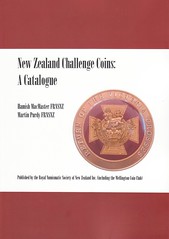 MacMaster, H., and Purdy, M., New Zealand Challenge Coins: A Catalogue, RNSNZ, Wellington, 2011
MacMaster, H., and Purdy, M., New Zealand Challenge Coins: A Catalogue, RNSNZ, Wellington, 2011
A4, soft cover, 124 pages, colour illustrations.
Edition limited to 120 copies.
ISBN 978-0-473-19541-0
Price including postage NZ$45 anywhere within NZ; A$45 to Australia and US$50 elsewhere.
The new catalogue of NZ Challenge Coins was officially launched at the Christmas meeting of the Royal Numismatic Society of New Zealand on 7 December. This is the second book in the series of paranumismatic/exonumia titles that the Society is publishing, following the 2009 “MacMaster” Catalogue of New Zealand Commemorative Medals 1941-2007, and is in the same general format.
The technical difficulty that beset the commemorative medals book at the last minute has been resolved, so the images are much clearer in the new publication, as well as being larger (50 mm rather than 35 mm), in colour and on semi-gloss rather than plain paper.
For those who are wondering what “Challenge Coins” are, they started out in life in the military, essentially as regimental/unit medals - the idea being that you carried one as a sort of ID token (a similar function to communion tokens, after a fashion), and the “challenge” part arose when a member of the unit would produce his example in the bar, and everyone else present had to do the same. Failure to come up with your medal meant you had to buy a round for everyone, or so the story goes.
They have moved on from there to become a subset of commemorative medals, marking regimental anniversaries, the commissioning of new navy vessels, overseas deployments (Sinai/Afghanistan/Timor), etc., and are now spreading to non-military issuers - various Government Ministers and Ambassadors carry them (to give out as goodwill/presentation items?) and there are examples from other civilian entities such as the Salvation Army or Civil Defence, to name but two. The RNSNZ also adopted the Challenge Coin format for its 80th anniversary medal in 2011.
There were eight Challenge Coins listed in an appendix to the 2009 catalogue of post-1940 medals, and since then we (mainly Hamish) have tracked down over 200 made for, or associated with, New Zealand entities, which we realised needed a book of their own. More and more examples have been surfacing on the on-line auction site TradeMe, though mintages for individual types are generally low. While some may be sold to anyone who wants one, others are issued only to members of the unit or crew at a specific event.
Listings in the book are grouped into three sections: Armed Forces, Ministers of the Crown and New Zealand Others (Governmental / Civilian), with further subdivisions under these headings. Because few are actually dated, they are not generally grouped chronologically, though some sub-sets appear in date order where it appeared possible and logical to do so (e.g. dated issues marking the commissioning of NZ Navy vessels). Full descriptions are given where available, and all major types are illustrated. Prices are not given as a rule, though some recent sale prices observed by the authors have been noted as a rough guide.
The item on the cover was issued to mark the recovery of the medals stolen from the National Army Museum at Waiouru a few years ago. The makers initially used the incorrect legend RETURN OF THE VICTORIA CROSSES but these were withdrawn (limited numbers were given to dignitaries and staff at Waiouru; the rest were sent back to the makers) and a corrected version made in a slightly larger run reading RETURN OF THE MEDALS.
Contact either of the authors directly at hamish.macmaster@mfat.govt.nz or martin@translatelimited.com to order a copy. For convenience, buyers can pay by Paypal (US$52.50 to translate@slingshot.co.nz, or alternatively US$50 if you select the “buyer pays fees” option). p>
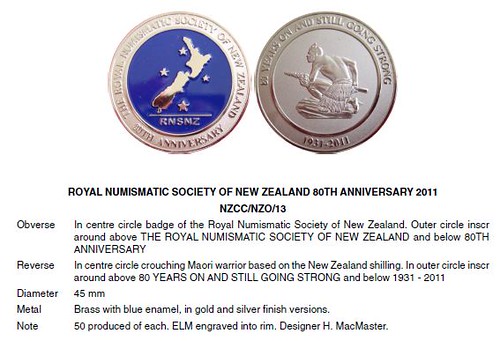
Sample entry
NEW PERIODICAL: EL SITIO

Horacio Morero of Montevideo, Uruguay writes:
I would like to announce the new electronic publication of our numismatic society: the Instituto Uruguayo de Numismática. The name of the publication is EL SITIO, in honour of our famous silver coin 1 Peso 1844 or Peso del Sitio. Unfortunately the publication is only in Spanish, but I think it can be read anyway.
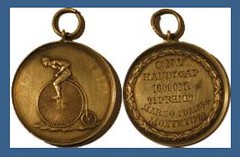
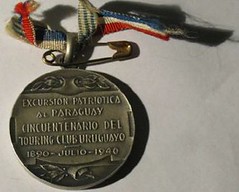
Horacio adds:
We sent the first number by email... it is free. In March 2012 we hope to have the web site and El Sitio will be available there. For the moment, your readers can obtain copies of the issues at the following web site -it is a nice Spanish numismatic site-: www.numisma.es/IUN/
Here's a direct link to issue #1: www.numisma.es/IUN/001.pdf
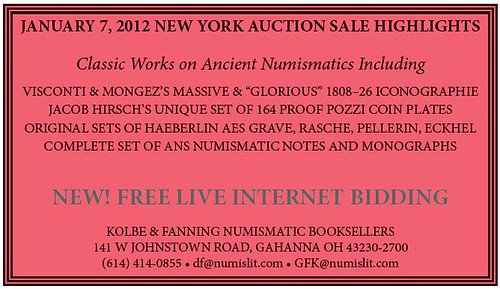
BOOK REVIEW: CHERRYPICKERS GUIDE, FIFTH EDITION, VOLUME II
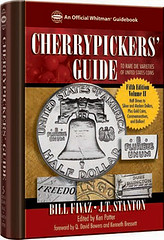 Cherrypickers’ Guide to Rare Die Varieties of United States Coins, 5th Edition, Volume ll, 2012, By Bill Fivaz and J. T. Stanton, Edited by Ken Potter, Foreword by Q. David Bowers and Kenneth Bressett.
Cherrypickers’ Guide to Rare Die Varieties of United States Coins, 5th Edition, Volume ll, 2012, By Bill Fivaz and J. T. Stanton, Edited by Ken Potter, Foreword by Q. David Bowers and Kenneth Bressett.
Reviewed by John and Nancy Wilson, NLG
The Cherrypickers’ Guide to Rare Die Varieties of United States Coins, 5th Edition, Volume ll, 2012, covers Half Dimes through Gold, Commemoratives, and Bullion Coinage, and is another “An Official Whitman Guidebook.” Bill Fivaz and J. T. Stanton, two good friends, have for many years been the standard bearers for the collecting of die varieties with their Cherrypickers’ Guide(s). Now, with the addition of Ken Potter as Editor, he brings a new set of ideas, thoughts and expertise to an already best-selling reference. Much of his own research and photographs have been included in this reference.
The three pages of Credits and Acknowledgments is a who’s who of numismatic experts who have also added very important input to this reference. This edition is dedicated to well-known dealer and longtime numismatist Larry Briggs.
This wonderfully done hardcover, spiral bound reference has 512 pages and is loaded with many well done illustrations. The 4th edition of this reference was published in January, 2006 and had 32 pages less than this 5th. In this new and revamped edition you will find over 100 new varieties that have been listed. You will also find a new chapter that covers modern silver, gold, and platinum bullion-coin varieties.
The Chapter on “How to use this book,” covers Symbols and Abbreviations Used in this Book; Variety Value and Normal Value and Factors Affecting Value along with the Values for Actively Traded Varieties. The Sheldon Scale is explained along with the Bower’s Universal Rarity Scale (URS). The Sheldon Scale explains and quoting this reference, “that the 1955 Doubled-Die Lincoln cent would be considered “common” or not so common. Yet we know it is in fact scarce or rare.”
Numismatist Q. David Bowers developed the Bowers Universal Rarity Scale in 1992 (June, 1992 - The Numismatist) which assigns a code, URS-0 to URS-22, for the numerical rarity from none known to 2,000,000. This scale can be used for almost anything and is used throughout the Cherrypickers’ Guide.
Also of great use in this Chapter is the Interest Factor (the rating for each variety’s interest from I-1 to I-5). This factor indicates how in demand this variety is. The Liquidity Factor (the rating from L-1 to L-5) indicates how quickly or how easily a coin or variety should sell. You will also find other useful information on average die life; changes to this volume of the Cherrypickers’ Guide; treatment of new variety listings and removal of low-interest and debunked varieties.
The Appendices cover many important topics.
Appendix A. Doubled dies vs. other forms of doubling. One of the most confusing parts of error collecting is the definition of doubled dies vs. other forms of doubling such as strike doubling.
Appendix B. The minting process explains the making of a coin.
Appendix C. Describes the best magnifiers.
Appendix D. Lists the popular varieties in proof and mint sets.
Appendix E. The use of courtesy and respect when looking through a dealers stock. This important part of the book will give you excellent information on how to act when at a dealers table.
Appendix F. 1979-S and 1981-S proof and mark varieties. The 24 blowups of the varieties (Cents through Dollars) will let you take your coin and find exactly what type it is.
Appendix G. Lists recommended reading. This four page Bibliography of recommended readings will give you sources you may not have known about.
Appendix H. Lists various coin clubs of interest to cherrypickers.
Besides the specialized and online organizations, we highly recommend joining the American Numismatic Association (ANA) if for nothing else, but to use their comprehensive library which contains many references on variety collecting. A CONECA application will be found on page 486.
Appendix I. The Fivaz-Stanton numbering system changed in the fourth edition. The new system gives more flexibility for adding additional varieties in the future and a cross-reference chart gives both the new and old numbers to allow easy conversion. This edition adds silver, gold and platinum coins, along with a listing of around 800 varieties. With the addition of this new chapter that covers modern silver, gold, and platinum bullion-coin varieties, the reference will bring in new collectors of this type of numismatic items. It will also have dealers and collectors who could care less about bullion – except the changing price – looking for the die varieties mentioned in this important Cherry Pickers’ Guide.
This new Cherry Pickers’ Guide by Fivaz, Stanton and Potter will be one of the best sellers for Whitman Publishing, LLC in 2012. We predict high honors at the next NLG gathering at the ANA - WFOM in Philadelphia in 2012 for this 5th Edition, Volume Two of the Cherry Pickers’ Guide. We highly recommend this guide for any collector, dealer, researcher, scholar or investor. After reading it, we are sure it will stimulate the collecting of die varieties of U. S. Coins and Bullion.
For information regarding Cherrypickers’ Guide to Rare Die Varieties, 5th edition, volume II, which was released in November, 2011 by Whitman Publishing, LLC for $39.95, you can contact Whitman Publishing, LLC, 3101 Clairmont Rd., Suite G., Atlanta, GA 30329, Phone No. (800) 546 - 2995 or visit their site at http://whitmanbooks.com
THE BOOK BAZARRE
HERITAGE TO OFFER ROOSEVELT COINAGE REDESIGN 'GENESIS LETTER'
 On Dec. 27, 1904, President Theodore Roosevelt wrote a personal letter to his secretary of the Treasury, Leslie Mortier Shaw:
On Dec. 27, 1904, President Theodore Roosevelt wrote a personal letter to his secretary of the Treasury, Leslie Mortier Shaw:
“My dear Secretary Shaw:
“I think our coinage is artistically of atrocious hideousness. Would it be possible, without asking permission of Congress, to employ a man like Saint-Gaudens to give us a coinage that would have some beauty?”
This brief letter explained the president’s opinion about the art on current U.S. coinage, and asked if he could have someone like Augustus Saint-Gaudens redesign the coins. It was the “genesis” — the beginning — of the renaissance of American coinage design that produced new, modern, creative designs on U.S. circulating coins over the next generation.
The letter to Secretary Shaw has been often quoted, but the references have all been from a copy held by the Library of Congress. The original, delivered as personal mail and not official correspondence, has been hidden — until now.
After more than a century, the original letter signed by President Roosevelt has been discovered. Few documents of American numismatics come close to the importance of this letter.
Dated Dec. 27, 1904, the letter was written on White House stationery, marked “Personal,” and is addressed to “Hon. L. M. Shaw, Secretary of the Treasury.” Following this personal letter, a flurry of official correspondence and personal letters show how the medal and coin design project developed over the next two-and-a-half years.
According to Heritage Auctions, the letter was recently discovered in a group of letters and other documents signed by various presidents and notable Americans including Benjamin Franklin, William Henry Harrison and John F. Kennedy.
The group of letters, including this one signed by Theodore Roosevelt, was purchased in Long Island by a part-time book and manuscript dealer and collector.
The genesis letter to Secretary Shaw is the original as signed by President Theodore Roosevelt. It was the personal property of Secretary Shaw until it passed to others by unknown means. It is not only a vibrant part of American history, but it is the point of origin for the collaboration of Roosevelt and Saint-Gaudens that led to the complete redesign of America’s coinage. A large part of U.S. numismatic heritage would be missing if this letter had never been written
To read the complete article, see: Roosevelt redesign 'genesis letter' surfaces (www.coinworld.com/articles/roosevelt-redesign-genesis-letter-surfaces/)
OLYMPIC MEDAL ARTIST DUGALD STERMER DIES
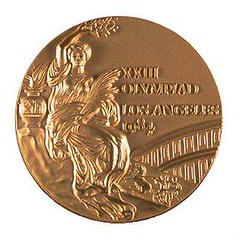

Images from www.digalist.com/list/2174
As the art director of the influential counterculture magazine Ramparts, artist Dugald Stermer had already left an imprint on popular culture when he was asked to update the design of the Olympic medals for the 1984 Games in Los Angeles.
At their unveiling, Stermer recognized the historic reach of the project by saying he was delighted that "the medals will last a lot longer than I will."
Known for treasuring classic typography, he brought the same eye to the medallions. He mainly added depth and definition to the figure of Lady Victory that graces the front of the medal created in 1928 by Florentine artist Giuseppe Cassioli.
On the back, Stermer restored the original design, which had not been used since the 1968 Games. He added musculature to the scene of male athletes carrying the victor and made one other subtle yet significant change — he modified their facial features to reflect the ethnic diversity among Olympians.
Stermer, who also was a noted wildlife illustrator and chaired the illustration department at California College of the Arts, died Dec. 2 of respiratory and cardiac failure at California Pacific Medical Center in San Francisco, said his daughter, Megan. He was 74.
"He was extremely honored to be designing the medals," his daughter said. "He said it was so meaningful from a personal standpoint."
From 1964 to 1970, Stermer was at the visual helm of Ramparts, giving the young San Francisco-based publication a stylized look that helped transform it into the leading magazine of the American left.
"The design and visual content were critical, an absolutely indispensable part of the magazine's success," according to Peter Richardson, who wrote a 2009 book on Ramparts.
To read the complete article, see: Dugald Stermer dies at 74; artist updated 1984 Olympic medals (articles.latimes.com/2011/dec/24/local/la-me-dugald-stermer-20111224)
MORE ON ED MILAS
Joe Foster of Midlothian, VA writes:
I just had to write a few words about Eddie Milas' passing........
 I first met Ed in 1962 in Waukegan Illinois. I was a junior in high school, working after school in a coin shop, called Mel-ode coins (owned by Erv Beskow & Jack Melcher), which was across the street from Waukegan High School. I don't believe he had yet founded Gold Stella, but was still a "vest pocket dealer", but I could be wrong. I know he came to meetings of the Lake County Coin Club, that I was a member of since 1959.
I first met Ed in 1962 in Waukegan Illinois. I was a junior in high school, working after school in a coin shop, called Mel-ode coins (owned by Erv Beskow & Jack Melcher), which was across the street from Waukegan High School. I don't believe he had yet founded Gold Stella, but was still a "vest pocket dealer", but I could be wrong. I know he came to meetings of the Lake County Coin Club, that I was a member of since 1959.
I graduated in 1963 and worked part time in construction and semi-full time at the coin shop now called Waukegan Coin and Supply relocated to Lewis Ave. and now owned wholly by Erv Beskow and his wife Sharon. We soon acquired a teletype machine for buying and selling, and I would operate it most of the time as I was only one that could type!!!
Ed would come to the new location occasionally, and one day brought a nice collection of Canadian tokens listed by Breton, which i purchased from him in late 1964 or early 1965 and he let me make payments on it , as it was several hundred dollars at the time and a lot of money for me!!!! Things slowed down in 1965 in our business , and I left Waukegan for Richmond, VA in the fall of 1965 to go into construction full time.. I know i corresponded with him and finished paying for the collection in Richmond.
I believe he had started Gold Stella, and later on, of course RARCOA. I know I corresponded with him for several years, and he occasionally found something for me in my collecting interests of Canadian tokens, medals and numismatic literature...
He was only 5 years older than me, but was always very good to me, sharing his knowledge readily....He was a good guy....my respects and condolences to his family.
To read the earlier E-Sylum article, see: ED MILAS 1940-2011 (www.coinbooks.org/esylum_v14n53a07.html)
A GROUNDBREAKING NUMISMATIC ADVERTISEMENT
I told this story once before, it was mentioned in part one on the history of Coin World (in Coin World, April 5, 2010) but the ad was reproduced again in this week's Coin World (January 2, 2012, page 20). So perhaps it needs retelling.
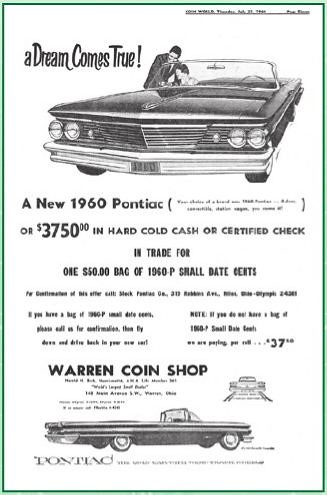
It was 1960, the first year of Coin World. I was hired from the staff of the Kansas City Kansan to become the first editor of Coin World. One of the big news events that first year was the action of the U.S. Mint of making cents with smaller dates than normal. Small Date Cents caught the imagination of the entire field, and we at Coin World fanned the fire.
We ran pictures of the date size variety on the front page and advertisers offered the new variety from both Philadelphia and Denver -- singles, sets and in rolls. They were scarce enough that made them desirable as a "must have variety," yet plentiful enough they were still available in quantity. Even by the bagful. Philadelphia coin dealer Harry Forman was the principle promoter of the new variety, he offered to buy or sell, any quantity!
One day in July 1960 I received a call from Harold H. Berk, the owner of the Warren Coin Shop. He also owned a car dealership in Warren, Ohio. It is not unusual for car dealers -- new or used -- to have an interest dealing in coins. The appeal is the same, buy and sell, condition and variety is everything, so is the ability to negotiate.
As editor of Coin World that first year I did everything, write news articles, sell advertising, process classified ads, attend numismatic conventions, everything but subscriptions. I took Harold Berk's call, he dictated the text of an ad to me on that phone call. My shorthand at that time was to write down all nouns with no verbs, I would reconstruct the exact text on the typewriter immediately after. He wanted to trade a brand new Pontiac from his dealership for a $50 bag of small date cents.
"How big you want that ad?" I asked thinking this might a small ad. "Full page," he answered.
My mind raced. Here was an opportunity I was seeking since I started Coin World. You have to know that all the ads in existing coin publications at the time were all text, no artistic treatment. Most were tabular lists of dates and mintmarks and prices. Gray lines of type that filled every ad.
With a full page I could do something closer to what an ad agency would do. I raced downstairs to the ad department of the Sydney Daily News in the same building. Having worked in the advertising department of the Kansan I knew my way around an ad department. I hit the Daily News "clip book" -- this is a subscription service to newspapers offering stock art work that you would "clip," actually cut out and paste up to create your own ads.
Berk was a Pontiac dealer. I found two Pontiac illustrations I could use. I also grabbed an appropriate headline. Back at my desk I pasted up a full page and typed up my notes indicating what text went in what area on the paste up. I sent the ad to the composing room.
The ad appeared in the July 21, 1960 issue of Coin World. It hit the numismatic field with a Bang. It made news. The day it was printed I walked across the hall to the Daily News newsroom and had the news item "an Ohio car dealer was offering a new car for a $50 bag of cents" sent out on the AP newswire.
The ad made national news. It even made Time Magazine the following week!
Harold Berk became famous in the numismatic field. His ad was the talk everywhere coin collectors gathered. He eventually was elected to the board of Governors of the American Numismatic Association.
Fast forward to 1966. I had left Coin World, returned to Kansas City and started another coin publication, sold it to a group of investors in Houston, moved there and started another coin publication. Meanwhile the ANA had a new headquarters building in Colorado Springs, Colorado. The organization needed a new editor to serve in that capacity in Colorado.
I wanted that job. But so did Ed Rochette, who was editor of Numismatic News in Iola, Wisconsin. The decision was to be made by the nine-member board of the ANA. John Pitman was a good friend and a member of the board at that time. He was my inside board contact and I had him campaign for my candidacy for the editor position.
The vote was taken August 23, 1966. John had four votes lined up for me. Four favored Ed. The swing vote was none other than that same Harold Berk. He voted for Rochette. Whether he was inconsiderate, or unappreciative, or didn't remember what I had done for him six years earlier, I do not know. But Ed Rochette won the vote, left Numismatic News and became the editor of The Numismatist.
(Later that year I was offered the position of Director of Research at Medallic Art Company, which I accepted. Ironically I ended up editing MACO's publication, The Art Medallist.)
NEW WORD: EXOGRAPHICA
I write now because Russ Rulau's word "Exonumia" was brought up for discussion. But my letter has no further elucidation on how he came up with it; instead, years ago this word led me to think of a similar word but for paper-related items. That word is "Exographica."
The word encompasses all sorts of paper collectibles except actual paper currencies. The Professional Currency Dealers Association (PCDA) felt that it was a useful enough term that they allowed me to use it in the booklet I prepared in 1992 for their distribution to newer collectors, "The Wonderful World of Paper Money!" On p. 44 I explain what this new term means; I call it The Great Paper Periphery.
In the first paragraph I talk about the thousands of paper items of interest to paper money collectors that are not actual notes, nor were they ever intended to be notes. The second paragraph gets to the nitty-gritty of the discussion, this way: "Kinds of items which generally fit this exographic category include but are not limited to checks and other fiscal documents, stagecoach, horsecar and trolley tickets, railroad passes and tickets, food stamp change, receipts of all kinds, most engraved items of paper, lottery tickets, labels, coupons of all sorts, military passes, pictorial advertising, letterheads, souvenir cards, diplomas, announcements, autographs, insurance policy forms, various awards, and the like."
One can be an Exographist (accent on the o), collect Exographic items, have an interest in all or some aspects of Exographica. All of it fits to paper just as Exonumia does to the token-medal field. As far as I know, no one has picked up on it, but maybe its' time has finally come. What do you think?
MORE ON THE RAYMOND-BEISTLE CHRISTMAS TREE COIN HOLDER
 I found the Raymond-Beistle Christmas Tree coin holder article in the December 25th issue of The E-Sylum very interesting. Besides my half dollar interests, I delight in researching and writing about Martin Luther Beistle whose accomplishments include the 1929 book The Registry of Half Dollar Varieties and Sub-Varieties.
I found the Raymond-Beistle Christmas Tree coin holder article in the December 25th issue of The E-Sylum very interesting. Besides my half dollar interests, I delight in researching and writing about Martin Luther Beistle whose accomplishments include the 1929 book The Registry of Half Dollar Varieties and Sub-Varieties.
I haven’t seen the depicted Christmas Tree coin holder but am not surprised by its existence. It appears to be a logical by-product of a long standing business arrangement between the Beistle Company and Wayte Raymond. Some grossly simplified background information will help explain this.
ML Beistle, a paper novelties and party goods manufacturer and advanced half dollar collector, invented the “Unique Coin Holder” in 1927; he filed for and was granted a patent in 1929 under number 1,719,962 (hence, the 1927 beginning anniversary date seen on the Christmas Tree coin holder). The original “Unique Coin Holder” (I’ve included a photo of an early model - there were many later variations and improvements) was a heavy white cover cardboard stapled and holed with white cloth tape on the edges, with transparent celluloid slides on both sides of the coin slots for each row of coins.
ML, thru the Beistle Company which he founded in 1900, invented the holders for handling his own collection of half dollars but eventually manufactured them on order for various individuals including Col E.H.R. Green before marketing and distributing them to the general public thru various agents including Scott’s Stamp and Coin Company then almost exclusively thru Wayte Raymond. Much later, Wayte Raymond used various agents such as Alan and Dorothy Faxon to distribute the holders. The patent for the “Unique Coin Holder” was eventually sold to Wayte Raymond.
The Beistle Company, Shippensburg, PA, still exists and ML’s great-granddaughter is now the President. In 2006-2007, I spent many enjoyable weeks combing thru the Beistle Company archives deriving much information on him, his coin holders, his half dollar collection, his half dollar book, and his other interests (I’ve written on him for various publications – for example, see The Asylum Volume 26, No. 1). Included in the archives were examples of the various holders with Wayte Raymond’s initials of approval and copies of individual and bulk sales invoices for the holders.
ML Beistle died unexpectedly while home from work for lunch at the age of 59 on January 11, 1935. Shortly thereafter, his son-in-law Henry E. Luhrs (also a prominent early half dollar collector; his collection remnants were sold by Heritage Auctions in 2006) became President of the Beistle Company and his name is also listed on the Christmas Tree coin holder.
Other information found on the Christmas Tree coin holder is easily explained and understood from this background. Thanks, Michael Sullivan, for sharing information on your coin holder. It is a wonderful piece of Beistle related memorabilia.
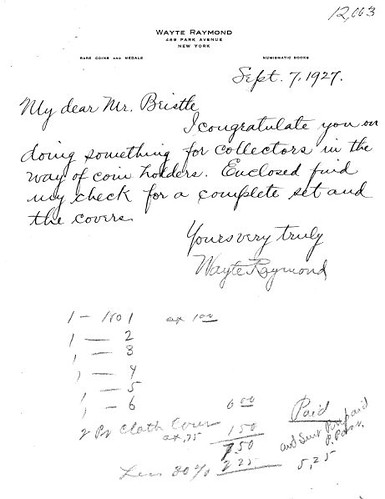
I'm writing in response to your illustration of the Raymond Christmas Tree in The E-Sylum.
I've seen this item once or twice before, though I've not been able to secure an example for my own collection. As you probably know, I'm writing a definitive history and catalog of coin albums, Volume One of which covers the products of Beistle, Raymond and Meghrig.
M. L. Beistle, in addition to writing his half dollar book, was the inventor of the Unique Coin Holder, manufactured by his own Beistle Company. The family-owned firm is still in business today, though it has not produced coin albums for more than 40 years. The Unique Coin Holder was a somewhat cruder version of what we know today as Wayte Raymond's National Coin Album.
Raymond acquired the rights from Beistle late in 1930, and he marketed them under the National brand for the next 40 years or so. Alan W. Faxon was his manager starting in the mid 1940s and carried on after Raymond's death, though Faxon himself lived just four years longer than Raymond. Faxon's widow then continued the business for the next ten years.
Henry E. Luhrs was Martin Beistle's son-in-law, having married Pearl Beistle in 1927. He succeeded Martin as president after the latter's death in 1935. Lurhs' grand-daughter Tricia Lacy is the company's current president, and I've been working with her in the preparation of my book.
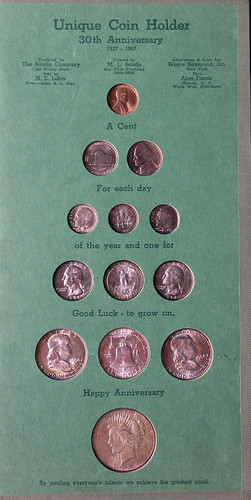

To read the earlier E-Sylum article, see: RAYMOND-BEISTLE CHRISTMAS TREE COIN HOLDER (www.coinbooks.org/esylum_v14n53a21.html)

MORE ON H.E. STONE AND S.D. STONE
Kay Olson Freeman writes:
Concerning Mike Paradis' inquiry - who are "H.E. Stone" and "S.D. Stone" of Morgantown, WV:
Harry E. Stone was born Dec. 31, 1883, Corry, Erie County, PA - Died January 31, 1959, Morgantown, WV. His wife was Sarah Day Stone (born 1884, PA - died March 23, 1949, Morgantown, WV) Starting in 1920's, Harry E. Stone was a Dean at West Virginia University in Morgantown until his death. Before that he had been a teacher various places in PA.
No mention is made of him being a coin and stamp dealer. Possibly a collector and not dealer. Maybe this is not correct person; but seems likely to me.
Mike adds:
He was a dealer to some degree. I have a ledger of his sales. There are hundreds of entries and names in the ledger that I recognize.

To read the earlier E-Sylum article, see: QUERIES: NUMISMATIC COMMUNICATIONS, H. E. STONE (www.coinbooks.org/esylum_v14n53a18.html)
QUERY: IRRADIATED COINS OF THE WORLD
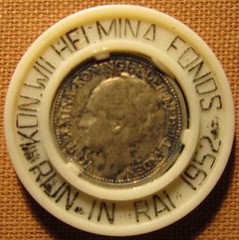
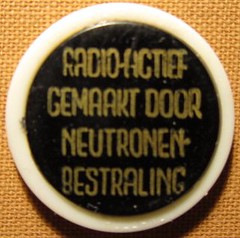
With much interest I read the contributions about the irradiated dimes in the latest issues of The E-Sylum. Irradiating dimes was not done only in the US. I have an example from the Netherlands. It is made of greenish-white, probably at one time fluorescent, and black plastic. Encased is a 10 cent coin of Queen Wilhelmina (Type 4, issued 1926 - 1945) made of 64% silver. The encasement has a diameter of 25 mm. The inscription on the Obverse reads: KON.WILHELMINA FONDS - RIJN IN RAI 1952. The Reverse reads: RADIOACTIEF GEMAAKT DOOR NEUTRONEN - BESTRALING (made radioactive by neutron irradiation). On the white rim the name of the manufacturer is written: LUXOR PLASTICS N.V. HOLLAND in small letters, not visible in the photograph.
The exhibition "De Rijn in de RAI" took place from 21 may until 15 june 1952 in Amsterdam. It was held because of the opening of the Amsterdam-Rhine Canal in that year. The major feature was an indoor model of the Rhine, 200 meters long, 10 m wide and 1 m deep. The Purpose of the Queen Wilhelmina Fund was to fund research into cures for Cancer. It was started in 1949. The encasement was probably issued to raise funds.
I would be interested to learn if irradiated dimes (coins) were issued as souvenirs in Other Countries.
To read the earlier E-Sylum article, see: CLIFFORD MISHLER AND OTHERS ON IRRADIATED DIMES (www.coinbooks.org/esylum_v14n53a13.html)
QUERY: UNIDENTIFIED COIN FROM THE EPIC HISTORY OF EVERYDAY THINGS
Ed Krivoniak writes:
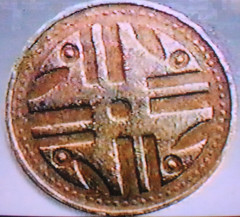 I watched a program called The Epic History of Everyday Things a few weeks ago and one of the segments was about money. They showed some hoard coins, a Greek coin, and a Ptolemaic coin to show early examples of money.
I watched a program called The Epic History of Everyday Things a few weeks ago and one of the segments was about money. They showed some hoard coins, a Greek coin, and a Ptolemaic coin to show early examples of money.
They also showed a coin which I could not identify. I took a picture of it and have shown it to everyone I know in Pittsburgh with no results as of yet. It appears to be 19th century but since only one side is shown and there is no inscription, no one has been able to identify it. The best supposition is that it is some kind of token. I hope that perhaps E-Sylum readers can identify it.
NOTES FROM E-SYLUM READERS: JANUARY 1, 2012
A Note from Darryl Atchison
Darryl Atchison of Ireland writes:
Keep up the good work with The E-Sylum; you really have no idea how much it is both enjoyed and appreciated.
A note from Tiesheng Li
Tiesheng Li writes:
I am a Chinese numismatist, a close friend of Howard Daniels for years. I have learned a lot from The E-Sylum and thanks for your long-term painstaking work.
New Subscriber: Nicolas Santerini
Horacio Morero, President of the Instituto Uruguayo de Numismática writes:
I would like to subscribe to The E-Sylum Nicolas Santerini, our secretary in the Instituto. I am sure Nicolás will enjoy The E-Sylum as I do. Congratulations for your continued effort. Really, The E-Sylum is an asset in the numismatic field.
MCA Meeting January 7, 2012
John Sallay forwarded this announcement:
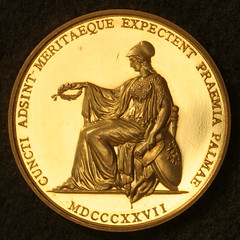 The Medal Collectors of America will hold its semiannual meeting at noon this Saturday, January 7, in conjunction with the New York International Numismatic Convention, at the Waldorf Astoria. John Sallay will present an illustrated talk entitled “Athena Leading the Way: The History of Her Medallic Iconography” and will trace the evolution of the symbolism related to Athena/Minerva on coins and medals since first used on ancient coins.
The Medal Collectors of America will hold its semiannual meeting at noon this Saturday, January 7, in conjunction with the New York International Numismatic Convention, at the Waldorf Astoria. John Sallay will present an illustrated talk entitled “Athena Leading the Way: The History of Her Medallic Iconography” and will trace the evolution of the symbolism related to Athena/Minerva on coins and medals since first used on ancient coins.
The gold medal pictured here, for example, was awarded by University College London in 1887 for Medical Jurisprudence and is closely patterned after Britannia, which herself was patterned after a second century sesertius of Antoninus Pius, which in turn was closely patterned after Athena/Minerva figures on earlier Greek and Roman coins – all of which will be illustrated. Everyone is welcome!
College Baseball Challenge Coins
Regarding this article about Challenge Coins at Brigham Young University in Salt Lake City, an E-Sylum reader writes:
The military tradition has spread to college baseball.
Players earned the coin through various requirements, such as completing the annual run up to the block Y on nearby Y Mountain last October.
“We are trying to continue the tradition of representing BYU in the right way,” said BYU coach Vance Law . “The coin is a reminder of the plus-one motto implying what Vice President (Kevin) Worthen challenged our department to be everything you can be.”
To read the complete article, see:
BYU Baseball Coin For 2012 Season
(www.deseretnews.com/article/705396319/BYU-Baseball-Coin
-For-2012-Season.html)
Douglas Yeo
Joe Boling writes:
Nice video about Daniel Chester French, recommended last week by Dick Johnson. In the credits at the end was a thank you to Douglas Yeo. Any relation to the numismatic Yeo?
To read the earlier E-Sylum article, see: A DANIEL CHESTER FRENCH VIDEO (www.coinbooks.org/esylum_v14n53a19.html)
Holey Dollar: Which Mint?
Dick Doty writes:
I wonder which mint the Holey Dollar was from. Probably Mexico City. Anybody know?
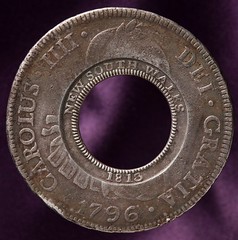
To read the earlier E-Sylum article, see: MUSEUM ACQUIRES 1813 NEW SOUTH WALES HOLEY DOLLAR (www.coinbooks.org/esylum_v14n53a16.html)
CALL FOR PAPERS: 2012 MEMPHIS INTERNATIONAL PAPER MONEY SHOW
Call for Papers
Memphis Speakers Series
2012 Memphis International Paper Money Show
June 8-10, 2012
Memphis is the paper money speaking event of the year!
We invite presentations on any fiscal paper or fiscal paper tie-in topic. We will have a packed program.
Deadline for submissions is April 1st so we have time to organize the program and send out press releases advertising your talk.
Talks are scheduled on the hour throughout the show. Each talk is allotted 50 minutes, which includes time for questions. Speakers arrive 10 minutes before the hour for setup.
You must use Powerpoint for your visuals. No exceptions. Lavishly illustrate your talk. Bring your own laptop or submit a disk with the presentation to Peter Huntoon two weeks in advance of the show.
You are welcomed to mount a parallel exhibit in the exhibition area.
Application requirements:
(1) list of presenter(s) with full contact information for each,
(2) title of talk,
(3) catchy concise newsworthy description of the content of your talk - this will be your primary draw,
(4) special needs such as up to three display cases for show-and-tell items.
Send applications to peterhuntoon@embarqmail.com.
THE SYDNEY EMDEN MEDAL

This is a commemorative medal issued in 1918 by the Australian Navy Board in remembrance of the naval battle of the HMAS Sydney with the German light cruiser SMS Emden.
The battle took place on November 9, 1914, off the Cocos (Keeling) Islands, about 1,350 miles to the northwest of the Australian continent. Not only did the Australians come out victorious in the encounter, it was also the first single ship action
German soldiers were paid in Mexican dollars in Tsing-tao, and also for its travels between Chinese and East Asian ports, the Emden carried this type of specie as means of payment in its cash box. It is reported that the Captain of a Norwegian ship was paid 100 Mexican dol-lars for the transport of the crew of an English ship which was intercepted and scuttled a few days before to a safe haven. On the Emden, a safe filled with Mexican dollars was reportedly still on the ship three months after the battle.
According to sources, 6,429 pieces were taken from the Emden, of which 1,000 were mounted as medals. This was carried out in 1918 by the Sydney jeweller W. Kerr, whose stamp is found on the reverse. These medals were presented by Captain John Glossop of the HMAS Sydney to the members of the ship who were on board during the engagement. Others were given to naval dignitaries, the staff on Cocos Islands, and museums. The remainder was sold to the public. Of the unmounted coins, 653 were distributed by the Department of Navy, 343 were sold to the public, and the remainder was melted for the relief fund of the Royal Australian Navy.
On the medals given to the crew, the name and the rank of the seamen were engraved on the back of the mount. Most medals I have seen are not named, however, considering the rarity of the medal, I am not sure that all 1,000 were indeed distributed. Additionally, it is very difficult to locate the unmounted Mexican dollars today. Apparently, they have not been specially marked, so they can only be identified by the accompanying letter from the Department of Navy with which they were sold.
Since many museums have gone online with their holdings, it is quite easy to find pictures on the internet by searching for ―Sydney Emden Mexican Dollar. All the pieces of eight used in the Sydney Emden medals that I have seen show a certain number of chopmarks, which is to be expected from coins that circulated for years or decades in East Asia. Actually, the item in my collection is one of the least chopped, with the coin being a good extremely fine. Other coins show heavier wear or have even been cleaned.
It is a highly intriguing numismatic item, a fascinating piece of Mexican-German-Australian history, a living example of the important role of Mexican silver in world trade and commerce, and, last but not least, most likely one of a very few chopmarked condecorations!
For more information on the Chopmark Collectors Club, see: chopmarks.org
THE BOOK BAZARRE
PRIVATE FIRM TO MANUFACTURE QUEEN’S DIAMOND JUBILEE MEDAL
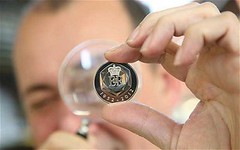 Many nine-year-old boys dream of being a train driver or an astronaut – and end up with a career in accountancy or health and safety management instead.
Many nine-year-old boys dream of being a train driver or an astronaut – and end up with a career in accountancy or health and safety management instead.
Phil McDermott, a 51-year-old from Birmingham, has stayed rather truer to the dreams of his youth. When he was nine, he started collecting medals. Forty-two years later, he has landed a £7 million contract to make 450,000 medals for the Queen’s Diamond Jubilee next year.
Worcestershire Medal Services, the small firm McDermott set up with his former wife in 1988 with a lump sum of £120, beat off competition from a stunned Royal Mint, which was founded more than 1,100 years ago. “This has caused one hell of a shock,” an insider recently told the Telegraph’s Mandrake column.
McDermott looks a little shocked himself. “It’s amazing,” he says in a soft Brummie accent, showing us round his factory in the city’s jewellery quarter. “I can’t believe I’m sat here making the Queen’s Diamond Jubilee Medal.”
It’s a fascinating story that touches on family as well as global history: a small regional business thriving in the face of globalisation, with a smattering of heroism, stoicism, two foreign coronations and a cameo appearance from Take That thrown into the mix.
“My mother thought the hobby would be a five-minute wonder,” says McDermott. Soon, however, he’d amassed quite a collection, including his uncle’s and his maternal grandfather’s from the First World War. Friends donated more. He wrote a book about the Distinguished Conduct Medal.
For him, the motivation was never profit – although he has an amusing anecdote about a friend discovering an Order of St Michael and St George, worth around £450, in a pub garden, and another picking up four rare gallantry medals for £1 each at a Scout jumble sale.
“I’m much more interested in the story behind a medal,” he says.
In 1988, bored by his career in IT and emboldened by the government’s Enterprise Allowance Scheme, which gave entrepreneurs £40 a week to start a business, McDermott founded the Worcestershire Medal Service. Initially, its main work was mounting medals for soldiers to wear with their uniforms.
“I thought the business would last about five years,” he says. “I hadn’t counted on the first Gulf War.”
Yugoslavia followed. Then Afghanistan. Iraq. War, it seems, is not just good business for arms manufacturers, mercenaries and John Simpson. Each time a soldier gets another medal – a dozen is not now unusual – they have to be remounted. Miniature versions are made for mess dress and black and white tie. “It’s a huge market,” says McDermott.
In 2004, he bought Gladman & Norman, a well-established Birmingham factory, and started manufacturing his own medals. In January 2008, it became one of four main companies, including the Royal Mint, to make OBEs and MBEs. It also started making medals for the Kingdom of Jordan, which led to a commission to mark the coronation of the King of Tonga. McDermott was invited to his birthday party. “White tie in Tonga in June…,” he sighs, puffing out his cheeks.
At the King of Tonga’s coronation, he met the sister of the future King of Bhutan, as you do. He had his own coronation on the horizon, so McDermott made around 1,500 medals, including the wonderfully named Order of the Druk Gyalpo. There was also a commission from an unnamed royal family for a celebratory medal studded with diamonds. Was it Dubai? Abu Dhabi? Brunei? “I can’t say,” says McDermott, smiling.
Meanwhile, back at home, the company was commissioned to make a medal for one of Take That’s music videos. More soberly, it designed and manufactured the Elizabeth Cross, a new medal commissioned in 2009 to honour the families of Britain’s war dead.
Earlier this year, McDermott was miffed when the Royal Mint beat Worcestershire Medal Service to the contract for the Olympics. He has got his revenge now, though, and is particularly delighted that it is a success story for Birmingham. The volume of work is such that he is sharing it with other companies in the city, which will help with the soldering, plating, cleaning, casting and hanging.
“This town has a long tradition of producing medals – right back to Matthew Bolton, in 1805, who gave medals to survivors of the Battle of Trafalgar,” says McDermott. “Birmingham has been hit hard by the economic climate, and the jewellery quarter in particular. Nearby Lozells [an area of west Birmingham] has the highest rate of unemployment in the country.”
McDermott is taking on four extra staff to add to his existing workforce of 22. Worcestershire Medal Service and its friends have to deliver 450,000 by February 6, the anniversary of the Queen’s accession. “I don’t think anyone has ever delivered so many medals in such a short timescale,” says McDermott. “It’s the biggest medals contract that has been put out by the government since the end of the First World War.”
To read the complete article, see: Medals: from collecting them to making them -collecting-them-to-making-them.html)
TITANIC ARTIFACTS TO BE AUCTIONED IN 2012
 The owner of the largest trove of artifacts salvaged from the Titanic is putting the vast collection up for auction as a single lot in 2012, the 100th anniversary of the world's most famous shipwreck.
The owner of the largest trove of artifacts salvaged from the Titanic is putting the vast collection up for auction as a single lot in 2012, the 100th anniversary of the world's most famous shipwreck.
More than 5,500 items including fine china, ship fittings and portions of hull that were recovered from the ocean liner have an estimated value of $189 million, according to Premier Exhibitions Inc., parent of RMS Titanic Inc. — the Titanic's court-approved salvor. That value was based on a 2007 appraisal and does not include intellectual property gathered from a 2010 scientific expedition that mapped the wreck site.
The auction is scheduled for April 1 by Guernsey's, a New York City auction house, according to filings by Premier Exhibitions Inc. with the Securities and Exchange Commission. Results of the auction won't be announced until April 15, the date a century ago the Titanic sank on its maiden voyage after striking an iceberg.
The auction is subject to approval by a federal judge in Virginia whose jurisdiction for years has given oversight to legal issues governing the salvage of the Titanic. The Titanic treasures were amassed during seven perilous trips to the wreck, which rests about 2 1/2 miles below the ocean surface in the North Atlantic.
A spokeswoman for the auction house and Premier Exhibitions declined Wednesday to discuss the auction with The Associated Press until a formal announcement in January.

To read the complete article, see: Titanic artifacts, more than 5,000 estimated at $189 million, headed to auction at Guernsey's (www.artdaily.org/index.asp?int_sec=2&int_new=52704)
A DOG LICENSE TAG COLLECTION

Be it brass, fiber or aluminum, if it’s a dog license tag from Michigan, there’s a good chance it’s in Tim Buda’s collection.
The Gaines Township man owns about 1,000 dog licenses from about 350 municipalities in the state, including tags that date back to the 1800s.
“It’s almost endless,” said Buda, 67. “There are so many different ones and different varieties.”
Buda took up collecting the licenses in 1985 after hearing about them while attending a coin show.
Fed up with the high cost and stress of collecting something where any imperfection can drop the item’s value, Buda ditched coins and took up dog licenses.
“In dog licenses, there is not great extreme in grading difference,” Buda said. “Just because there’s a little line or a mark, it doesn’t damage its value, where with coins, it got so ridiculous I sold everything I had.”
He counts among his collection an 1895 tag from Cadillac, an 1889 tag from Mackinac Island and a 1904 tag from Flint.
The size and shape of the tags vary, including tags shaped like dog houses, circles and canines.
Michigan licenses especially are sought after because there is such a variety.
From 1873 to 1917, each town and township issued its own tags. In 1919, state law changed to put the responsibility for the tags mostly into county hands, Buda said.
Buda isn’t alone in his pursuit.
He meets up with other collectors each year at the International Society of Animal License Collectors meeting.
The group has about 111 members from across the U.S., as well as countries such as Portugal and the Czech Republic, said William Bone, the secretary-treasurer of the group and editor of the society’s newsletter.
“It used to be people would say, ‘You collect what?’” Bone said. “I don’t get that much anymore.”
To read the complete article, see:
GAINES TOWNSHIP MAN BOASTS DOG LICENSE TAG COLLECTION OF OVER 1,000 PIECES
(sfluxe.com/2011/12/26/gaines-township-man-boasts-dog-license
-tag-collection-of-over-1000-pieces-mlive-com/)
FEATURED WEB PAGE: DIGITAL LIBRARY NUMIS
This week's Featured Web Page is Digital Library Numis, suggested by NBS President Dan Freidus, who writes:Here's a useful site I don't recall having seen before. It's a bibliography set up as a portal to open access versions of a broad range of numismatic books. It seems to be the work of an individual (T. Verspag?) who updates it periodically but not regularly.
Actually, we have highlighted this site at least once before, but it's high time to revisit it. From the site:
The purpose of the project Digital Library Numis (DLN) is to establish a major portal and digital repository for open access, e-books and e-papers, regarding coins and medals, the history of money, and otherwise related subjects.
The core body entails a broad variety of many rare and often beautifully illustrated numismatic classics produced from the 16th until the early 20th century. but we also offer an extensive survey of contemporary numismatic publications.
Digital Library Numis is particularly useful as a additional research tool for professional numismatists, other academics interested in the field, branch libraries and coin collectors.
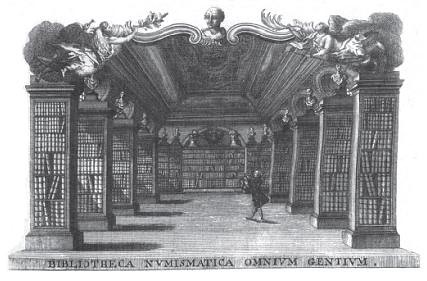
sites.google.com/site/digitallibrarynumis/

